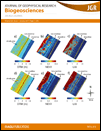
Quantifying and understanding the small-scale variability of nitrous oxide (N2O) and carbon dioxide (CO2) emission is essential for reporting accurate ecosystem greenhouse gas budgets. The objective of this study was to evaluate the spatial pattern of soil CO2 and N2O emissions and their relation to topography in a tropical montane forest. We measured fluxes of N2O and CO2 from 810 sampling locations across valley bottom, mid-slope and ridge top positions under controlled laboratory conditions. We further calculated the minimum number of samples necessary to provide best estimates of soil N2O and CO2 fluxes at the plot level. Topography exhibited a major influence on N2O emissions, with soils at mid-slope position emitting significantly less than at ridge tops and valley bottoms, but no consistent effect of topography on soil CO2 emissions was found. The high spatial variation of N2O and CO2 fluxes was further increased by changes in vegetation and soil properties resulting from human disturbance associated with charcoal production. Soil N2O and CO2 fluxes showed no spatial pattern at the plot level, with “hot spots” strongly contributing to the total emissions (10 % of the soil cores represented 73 and 50 % of the total N2O and CO2 emissions, respectively). Thus, a large number of samples are needed to obtain robust estimates of N2O and CO2 fluxes. Our results highlight the complex biogeochemical cycling in tropical montane forests, and the need to carefully address it in research experiments to robustly estimate soil CO2 and N2O fluxes at the ecosystem scale.








